Class 7 Maths Chapter 4 Simple Equations NCERT Solutions
- Class 7 Maths Simple Equations Exercise 4.1
- Class 7 Maths Simple Equations Exercise 4.2
- Class 7 Maths Simple Equations Exercise 4.3
- Class 7 Maths Simple Equations Exercise 4.4
NCERT Solutions for Class 7 Maths Chapter 4 Simple Equations Exercise 4.1
Ex 4.1 Class 7 Maths Question 1.
Complete the given column of the table: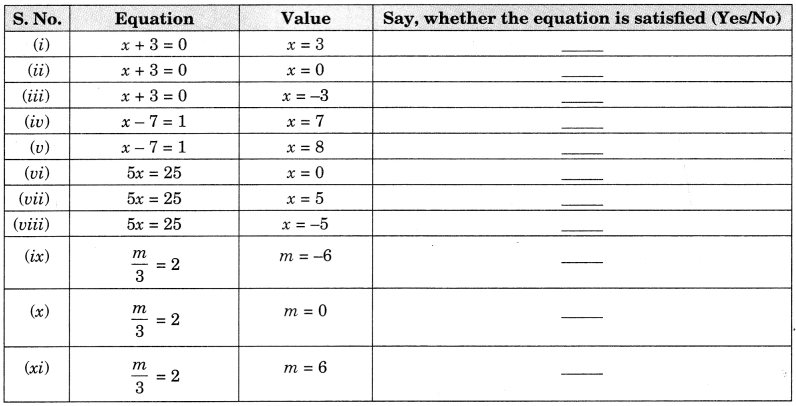
Solution:

Ex 4.1 Class 7 Maths Question 2.
Check whether the value given in the brackets is a solution to the given equation or not:
(a) n + 5 = 19; (n = 1)
(b) 7n + 5 = 19; in – -2)
(c) 7n + 5 = 19; (n = 2)
(d) 4p – 3 = 13; (p = 1)
(e) 4p – 3 = 13; (p = -4)
(f) 4p-3 = 13; (p = 0)
Solution:
(a) n + 5 = 19 (n = 1)
Put n = 1 in LHS
1 + 5 = 6 ≠ 19 (RHS)
Since LHS ≠ RHS
Thus n = 1 is not the solution of the given equation.
(b) 7n + 5 = 19; (n = -2)
Put n = – 2 in LHS
7 × (-2) + 5 = -14 + 5 = -9 ≠ 19 (RHS)
Since LHS ≠ RHS
Thus, n = -2 is not the solution of the given equation.
(c) 7n+ 5 = 19; (n = 2)
Put n = 2 in LHS
7 × 2 + 5 = 14 + 5 = 19 = 19 (RHS)
Since LHS = RHS
Thus, n – 2 is the solution of the given equation.
(d) 4p – 3 = 13; (p = 1)
Put p = 1 in LHS
4 × 1 – 3 = 4 – 3 = 1 ≠ 13 (RHS)
Since LHS ≠ RHS
Thus, p = 1 is not the solution of the given equation.
(e) 4p – 3 = 13; (p = -A)
Put p = -4 in LHS
4 × (-4) – 3 = -16 – 3 = -19 ≠ 13 (RHS)
Since LHS ≠ RHS
Thus p = -4 is not the solution of the given equation.
(f) 4p – 3 = 13; (p = 0)
Put p = 0 in LHS
4 × (0) – 3 = 0 – 3 = -3 ≠ 13 (RHS)
Since LHS ≠ RHS
Thus p – 0 is not the solution of the given equation.
Ex 4.1 Class 7 Maths Question 3.
Solve the following equations by trial and error method:
(i) 5p + 2 = 17
(ii) 3m – 14 = 4
Solution:
(i) 5p + 2 = 17
For p = 1, LHS
= 5 × 1 + 2 = 5 + 2 = 7 ≠ 17 (RHS)
For p = 2, LHS = 5 × 2 + 2
= 10 + 2 = 12 ≠ 17 (RHS)
For p = 3, LHS = 5 × 3 + 2
= 15 + 2 = 17 = 17 (RHS)
Since the given equation is satisfied for p = 3 Thus, p = 3 is the required solution.
(ii) 3m – 14 = 4
For m = 1, LHS = 3 × 1 – 14
= 3 – 14 = -11 ≠ 4 (RHS)
For m = 2, LHS = 3 × 2 – 14 = 6 – 14
= -8 ≠ 4 (RHS)
For m = 3, LHS = 3 × 3 – 14 = 9 – 14
= -5 ≠ 4 (RHS)
Form m = 4, LHS = 3 × 4 – 14
= 12 – 14 = -2 ≠ 4 (RHS)
For m = 5, LHS = 3 × 5 – 14
= 15 – 14 = -1 ≠ 4 (RHS)
For m = 6, LHS = 3 × 6 – 14
= 18 – 14 = 4 (=) 4 (RHS) .
Since, the given equation is satisfied for m = 6.
Thus, m = 6 is the required solution.
Ex 4.1 Class 7 Maths Question 4.
Write equations for the following statements:
(i) The sum of numbers x and 4 is 9.
(ii) 2 subtracted from y is 8.
(iii) Ten times a is 70.
(iv) The number b divided by 5 gives 6.
(v) Three-fourth of t is 15.
(vi) Seven times m plus 7 gets you 77.
(vii) One-fourth of a number x minus 4 gives 4.
(viii) If you take away 6 from 6 times y, you get 60.
(ix) If you add 3 to one-third of z, you get 30.
Solution: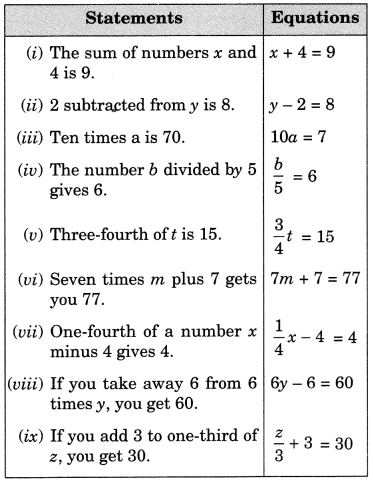
Ex 4.1 Class 7 Maths Question 5.
Write the following equations in statement forms.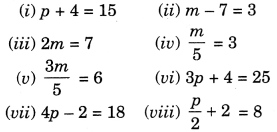
Solution: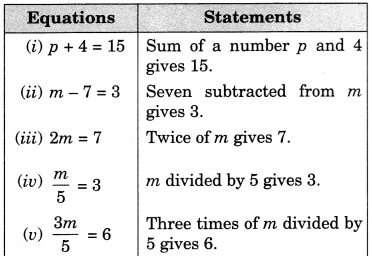
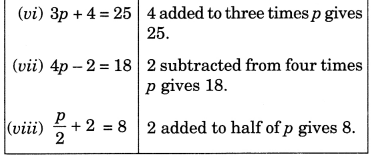
Ex 4.1 Class 7 Maths Question 6.
Set up an equation in the following cases:
(i) Irfan says that he has 7 marbles more than five times the marbles Parmit has. Irfan has 37 marbles. (Take m to be the number of Parmit’s marbles)
(ii) Laxmi’s father is 49 years old. He is 4 years older than three times Laxmi’s age. (Take Laxmi’s age to be y years)
(iii) The teacher tells the class that the highest marks obtained by a student in her class is twice the lowest marks plus 7. The highest score is 87. (Take the lowest score to be 1)
(iv) In an isosceles triangle, the vertex angle is twice either base angle. (Let the base angle be b in degrees. Remember that the sum of angles of a triangle is 180 degrees).
Solution:
(i) Let m be the Parmit’s marbles.
∴ Irfan’s marble = 5m + 7
Total number of Irfan’s marble is given by 37.
Thus, the required equation is 5m + 7 = 37
(ii) Let Laxmi’s age bey years.
∴ Laxmi’s father’s age = 3y + 4
But the Laxmi’s father age is given by 49
Thus the required equation is 3y + 4 = 49
(iii) Let the lowest score be l.
∴ The highest score = 2l + 1
But the highest score is given by 87.
Thus, the required equation is 2l + 1 = 87
(iv) Let each base angle be ‘b’ degrees.
∴ Vertex angle of the triangle = 2b
Sum of the angles of a triangle = 180°
∴ Required equation is b + b + 2b = 180° or 4b = 180°
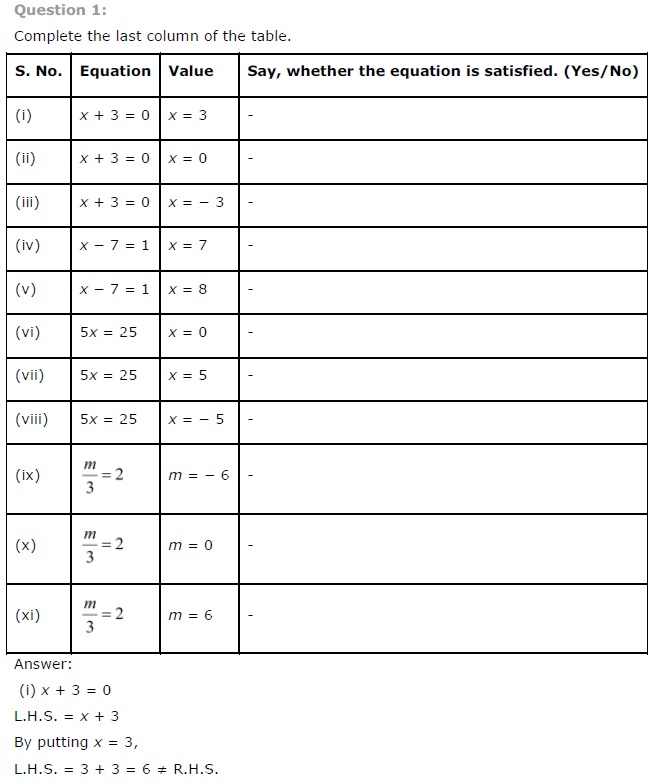
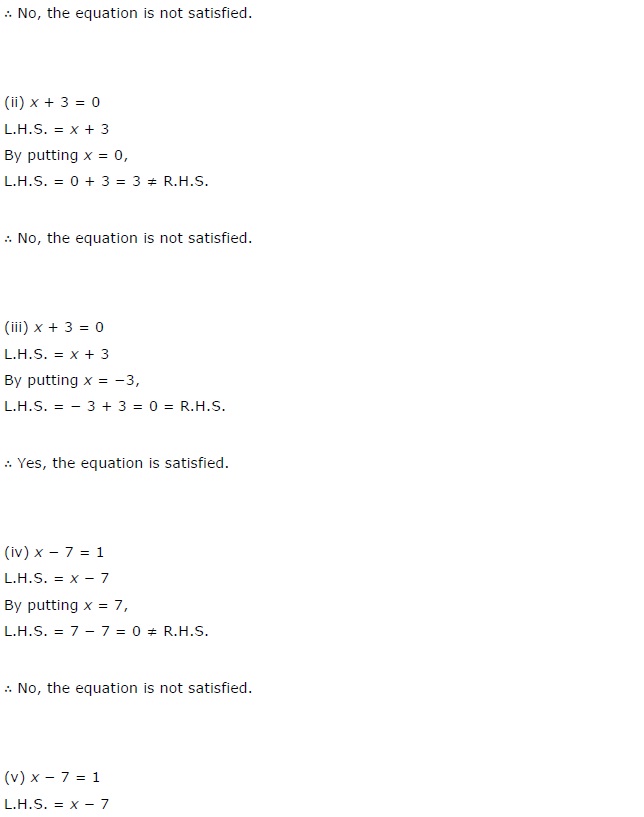
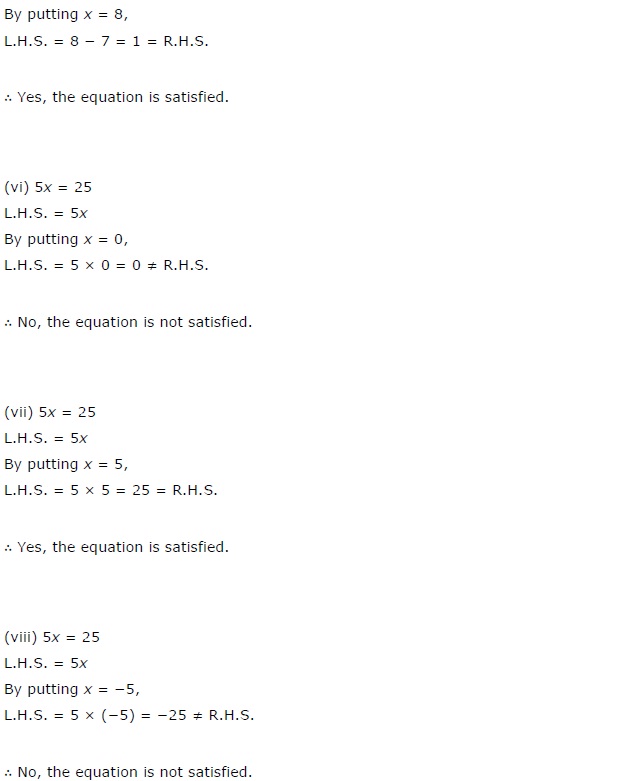
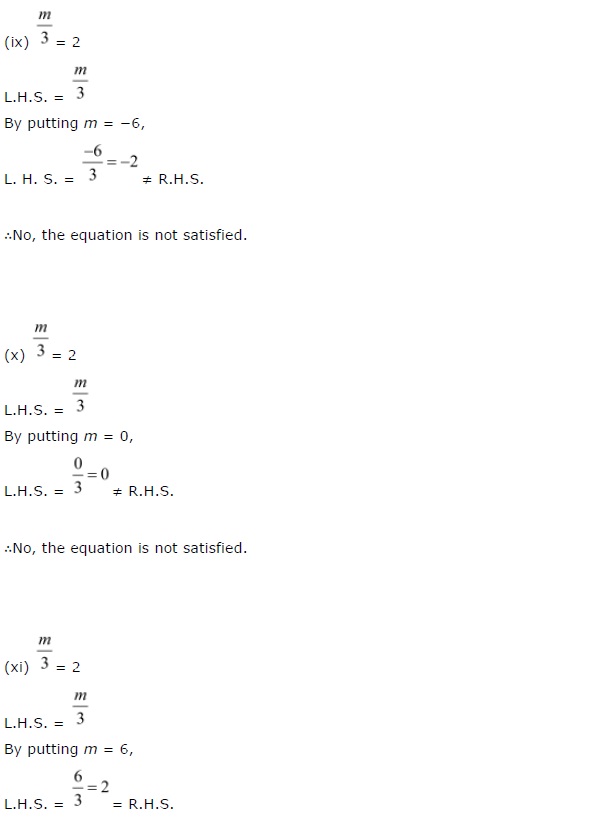
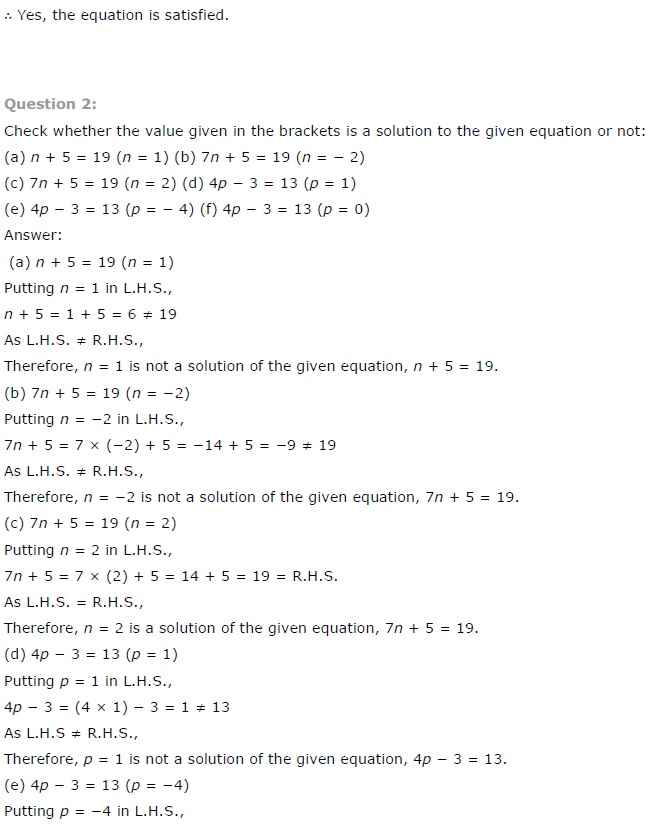
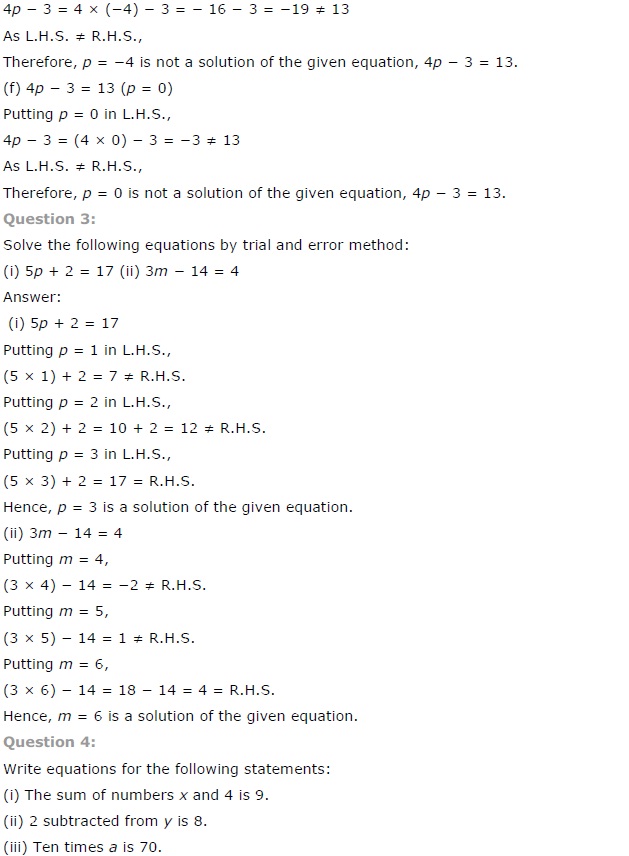

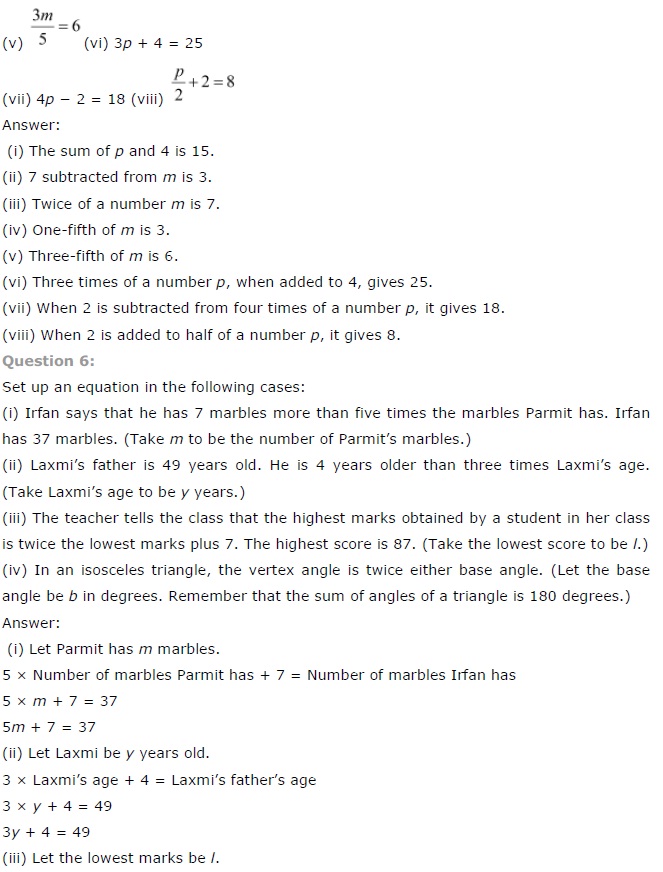
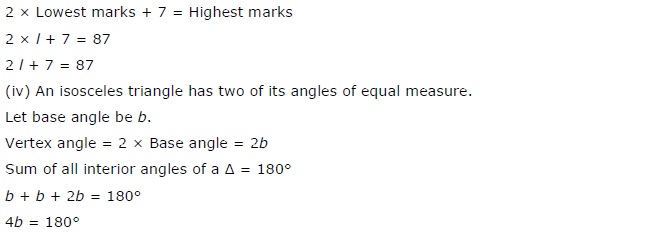
NCERT Solutions for Class 7 Maths Chapter 4 Simple Equations Exercise 4.2
Ex 4.2 Class 7 Maths Question 1.
Given first the step you will use to separate the variable and then solve the equation:
(a) x – 1 = 0
(b) x + 1 = 0
(c) x – 1 = 5
(d) x + 6 = 2
(e) y – 4 = -7
(f) y -4 = 4
(g) y + 4 = 4
(h) y + 4 = -4
Solution:
(a) x – 1 = 0
Adding 1 to both sides, we get
x – 1 + l = 0 + 1 ⇒ x = 1
Thus, x = 1 is the required solutions.
Check: Put x = 1 in the given equations
x – 1 = 0
1 – 1 = 0
0 = 0
LHS = RHS
Thus x = 1 is the correct solution.
(b) x + 1 = 0
Subtracting 1 from both sides, we get
x + 1 – 1 = 0 – 1 ⇒ x = -1
Thus x = -1 is the required solution.
Check: Put x = -1 in the given equation
-1 + 1 = 0
0 = 0
LHS = RHS
Thus x = -1 is the correct solution.
(c) x – 1 = 5
Adding 1 to both sides, we get
x – 1 + 1 = 5 + 1 ⇒ x = 6
Thus x = 6 is the required solution.
Check: x – 1 = 5
Putting x = 6 in the given equation
6 – 1 = 5 ⇒ 5 = 5
LHS = RHS
Thus, x = 6 is the correct solution.
(d) x + 6 = 2
Subtracting 6 from both sides, we get
x + 6 – 6 = 2 – 6 ⇒ x = -4
Thus, x = -4 is the required solution.
Check: x + 6 = 2
Putting x = -4, we get
-4 + 6 = 2 ⇒ 2 = 2 LHS = RHS
Thus x = -4 is the correct solution.
(e) y – 4 = -7
Adding 4 to both sides, we get
y – 4 + 4 = -7 + 4 ⇒ y = -3
Thus, y = -3 is the required solution.
Check: y – 4 = -7
Putting y = -3, we get
-3 – 4 = -7 ⇒ -7 = -7
LHS = RHS
Thus, y = -3 is the correct solution.
(f) y – 4 = 4
Adding 4 to both sides, we get
y – 4 + 4 = 4 + 4 ⇒ y = 8
Thus, y = 8 is the required solution.
Check: y – 4 = 4
Putting y = 8, we get
8 – 4 = 4 ⇒ 4 = 4
LHS = RHS
Thus y = 8 is the correct solution.
(g) y + 4 = 4
Subtracting 4 from both sides, we get
y + 4 – 4 = 4 – 4 ⇒ y = 0
Thus y = 0 is the required solution.
Check: y + 4 = 4
Putting y = 0, we get
0 + 4 = 4 ⇒ 4 = 4
LHS = RHS
Thus y = 0 is the correct solution.
(h) y + 4 =-4
Subtracting 4 from both sides, we get
y + 4 – 4 = -4 – 4 ⇒ y = -8
Thus, y = -8 is the required solution.
Check: y + 4 = -4
Putting y = -8, we get
-8 + 4 = -4 ⇒ -4 = -4
LHS = RHS
Thus, y = -8 is the correct solution.
Ex 4.2 Class 7 Maths Question 2.
Give first the step you will use to separate the variable and then solve the following equation: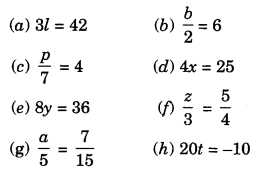
Solution: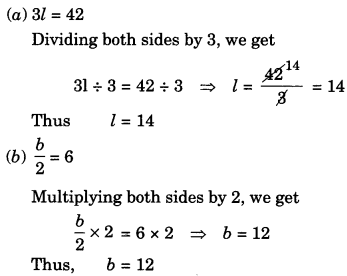
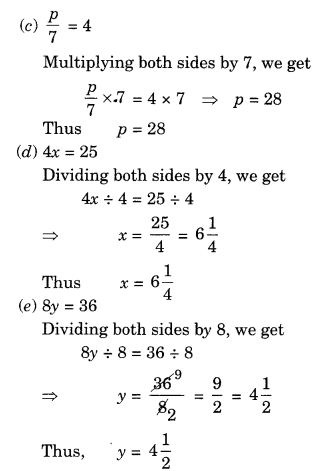
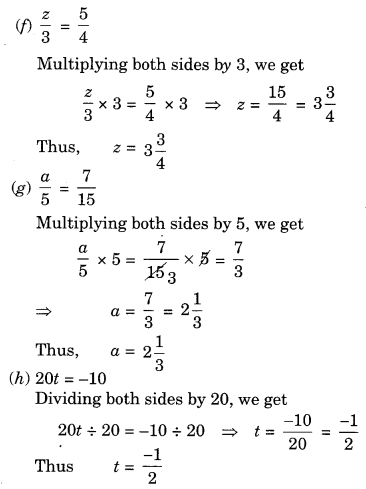
Ex 4.2 Class 7 Maths Question 3.
Give the steps you will use to separate the variables and then solve the equation:
(a) 3n – 2 = 46
(b) 5m + 7 = 17
(c)
(d)
Solution:
(a) 3n – 2 = 46
⇒ 3n- 2 + 2 = 46+ 2 (adding 2 to both sides)
⇒ 3n = 48
⇒ 3n + 3 = 48 ÷ 3
(b) 5m + 7 = 17
⇒ 5m+ 7 – 7 = 17 – 7 (Subtracting 7 from both sides)
⇒ 5m = 10
⇒ 5m + 5 = 10 ÷ 5 (Dividing both sides by 5)
(c) 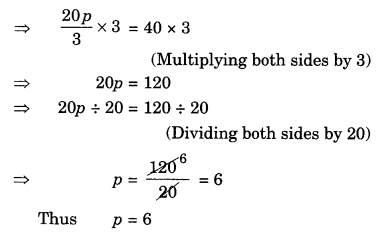
(d)
⇒
⇒ 3p = 60
⇒ 3p ÷ 3 = 60 ÷ 3 (Dividing both sides by 3)
Ex 4.2 Class 7 Maths Question 4.
Solve the following equations:
(a) 10p = 100
(b) 10p + 10 = 100
(c)
(d)
(e)
(f) 3s = -9
(g) 3s + 12 = 0
(h) 3s = 0
(i) 2q = 6
(j) 2q – 6 = 0
(k) 2q + 6 = 0
(l) 2q + 6 = 12
Solution:
(a) 10p = 100
⇒ 10p ÷ 10 = 100 ÷ 10 (Dividing both sides by 10)
Thus p= 10
(b) 10p + 10 = 100
⇒ 10p + 10 – 10 = 100 -10 (Subtracting 10 from both sides)
⇒ 10p = 90
⇒ 10p ÷ 10 = 90 ÷ 10 (Dividing both side by 10)
Thus p = 9
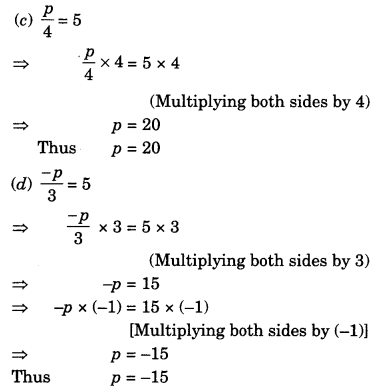
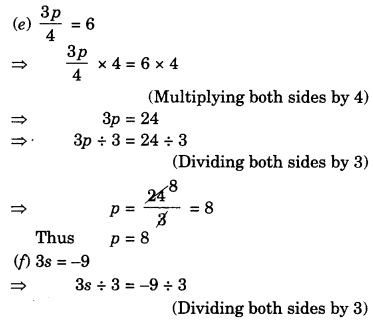
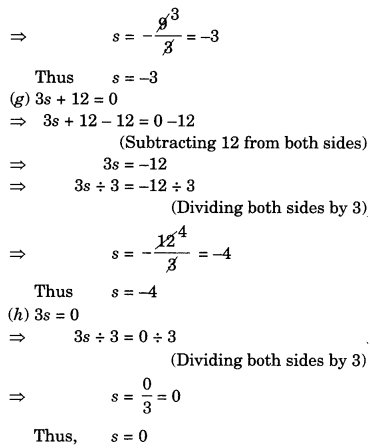
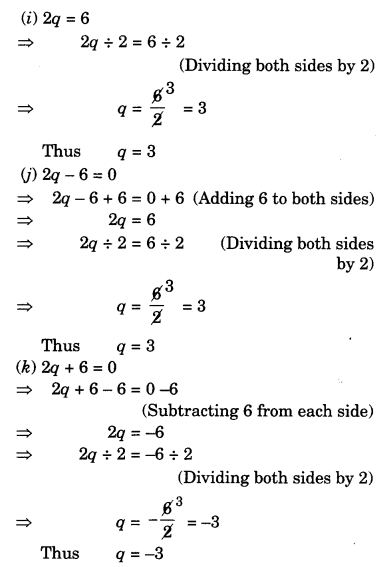
(l) 2q + 6 = 12
⇒ 2q + 6 – 6 = 12 – 6 ( Subtracting 6 from both sides)
⇒ 2q = 6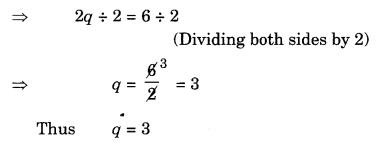
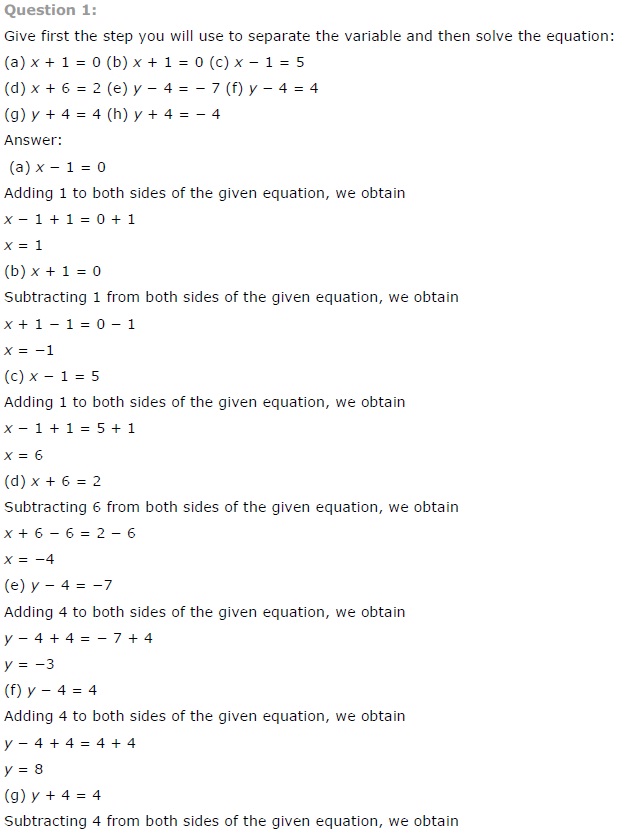
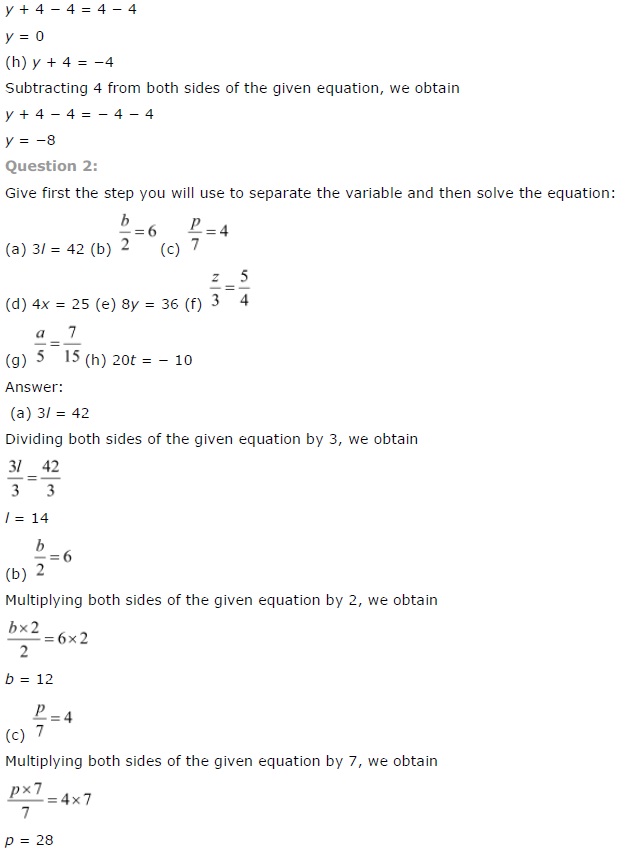
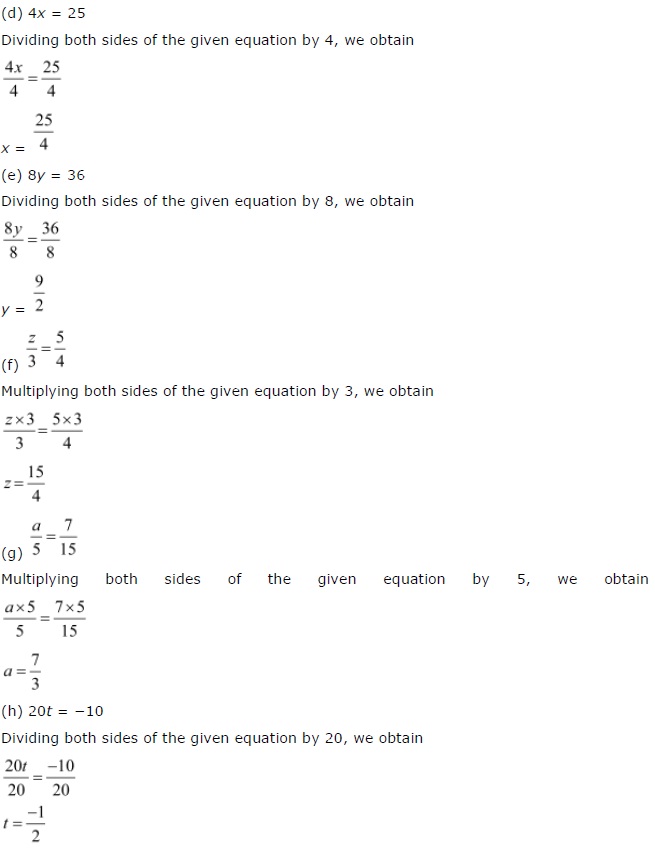

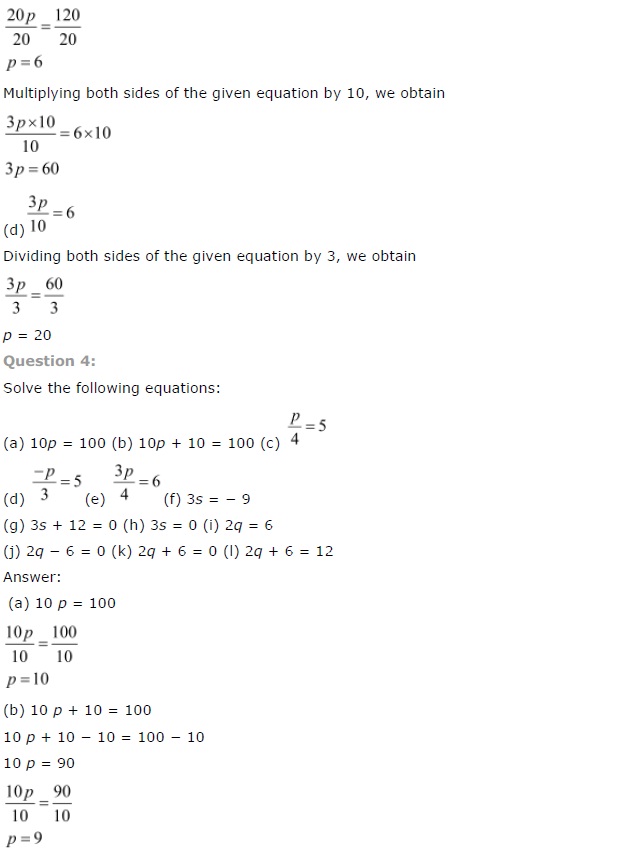
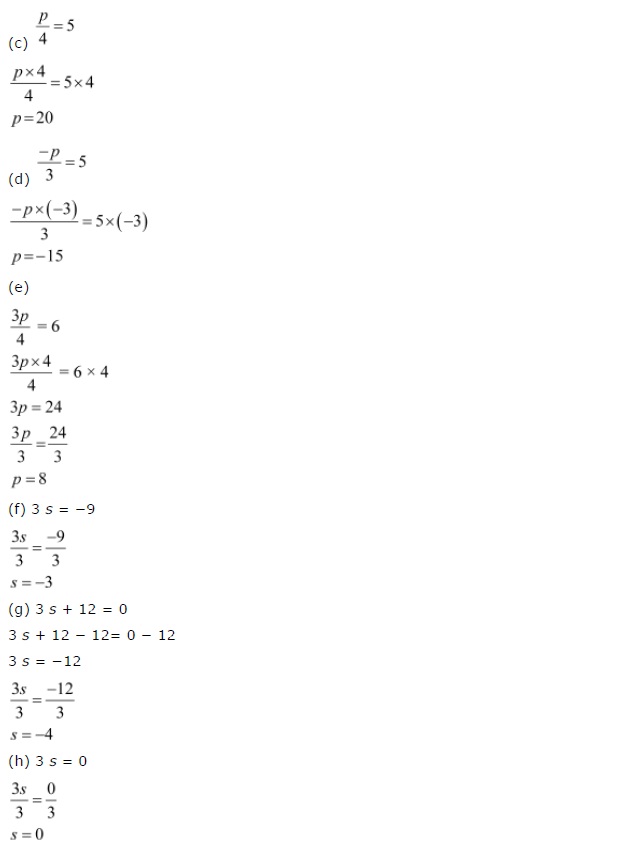
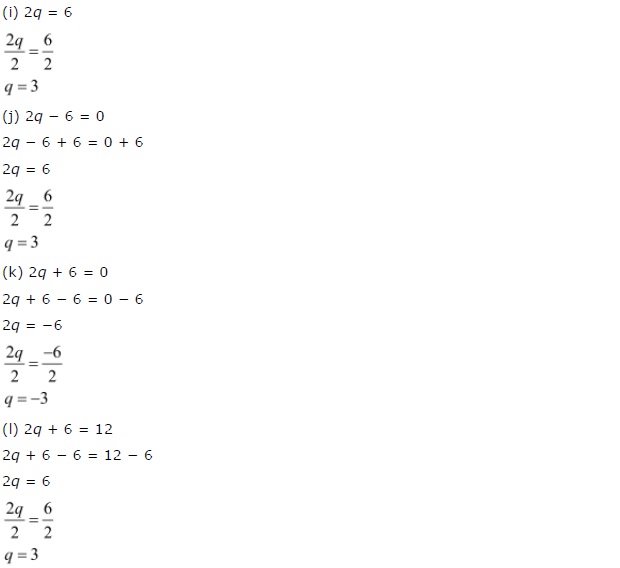
NCERT Solutions for Class 7 Maths Chapter 4 Simple Equations Exercise 4.3
Ex 4.3 Class 7 Maths Question 1.
Solve the following equations: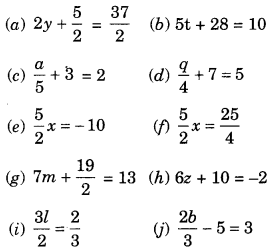
Solution: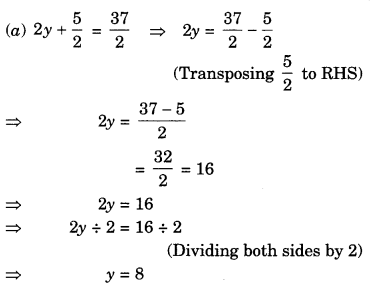
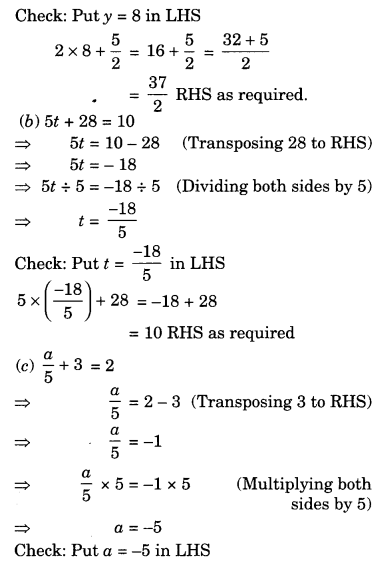
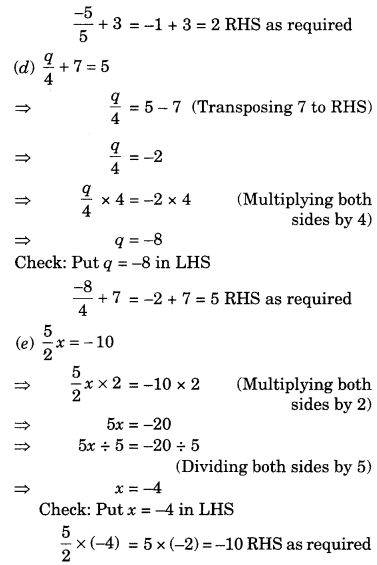
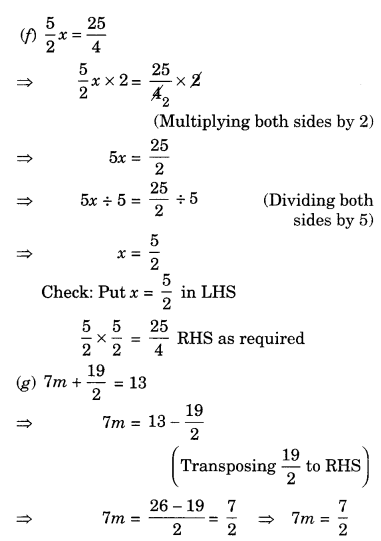
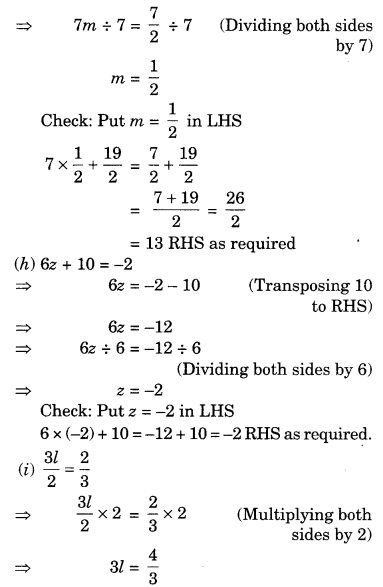
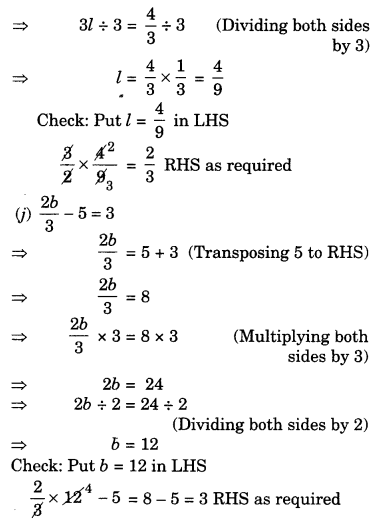
Ex 4.3 Class 7 Maths Question 2.
Solve the following equations:
(а) 2(x + 4) = 12
(b) 3(n – 5) = 21
(c) 3(n – 5) = -21
(d) -4(2 + x) = 8
(e) 4(2 – x) = 8
Solution:
(a) 2(x + 4) = 12
⇒
⇒ x + 4 = 6
⇒ x = 6 – 4 (Transposing 4 to RHS)
⇒ x – 2
Check: Put x = 2 in LHS
2(2 + 4) = 2 × 6 = 12 RHS as required
(b) 3(n – 5) = 21
⇒
⇒ n – 5 = 7
⇒ n = 7 + 5 (Transposing 5 to RHS)
n = 12
Check: Put n = 12 in LHS
3(12 – 5) = 3 × 7 = 21 RHS as required
(c) 3(n – 5) = -21
⇒
⇒ n – 5 = -7
⇒ n = -7 + 5 (Transposing 5 to RHS)
⇒ n = -2
Check: Put n = -2 in LHS
3(-2 – 5) = 3 × -7
= -21 RHS as required
(d) -4(2 + x) = 8
⇒
⇒ 2 + x = -2
⇒ x = -2 – 2 (Transposing 2 to RHS)
⇒ x = —4
Check: Put x = -4 in LHS
-4(2 – 4) = -4 × -2 = 8 RHS as required
(e) 4(2-x) = 8
⇒
⇒ 2 – x = 2 – 2 (Transposing 2 to RHS)
⇒ -x = 0
∴ x = 0 (Multiplying both sides by -1)
Check: Put x = 0 in LHS
4(2 – 0) = 4 × 2 = 8 RHS as required
Ex 4.3 Class 7 Maths Question 3.
Solve the following equations:
(a) 4 = 5(p- 2)
(b) -4 = 5(p – 2)
(c) 16 = 4 + 3 (t + 2)
(d) 4 + 5(p – 1) = 34
(e) 0 = 16 + 4(m – 6)
Solution:
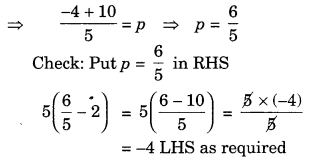
(c) 16 = 4 + 3 (t + 2)
⇒ 16 – 4 = 3(t + 2) (Transposing 4 to LHS)
⇒ 12 = 3 (t + 2)
⇒
⇒ 4 = t + 2
⇒ 4 – 2 = t (Transposing 2 to LHS)
⇒ 2 = t or t = 2
Check: Put t = 2 in RHS
4 + 3(2 + 2) = 4 + 3 × 4 = 4 + 12
= 16 LHS as required
(d) 4 + 5(p – 1) = 34
⇒ 5(p – 1) = 34 – 4(Transposing 4 to RHS)
⇒ 5(p – 1) = 30
⇒
⇒ p – 1 = 6
⇒ P = 7
Check: Put p = 7 in LHS
4 + 5(7 – 1) = 4 + 5 × 6
= 4 + 30 = 34 RHS as required
(e) 0 = 16 + 4(m – 6)
⇒ 0 — 16 = 4(m – 6) (Transposing 16 to LHS)
⇒ -16 = 4(m – 6)
⇒
⇒ -4 = m – 6
⇒ -4 + 6 = m (Transposing 6 to LHS)
⇒ 2 = m
or m = 2
Check: Put m = 2 in RHS
16 + 4(2 – 6) = 16 + 4 × (-4) = 16 – 16 = 0 LHS as required
Ex 4.3 Class 7 Maths Question 4.
(a) Construct 3 equations starting with x = 2
(b) Construct 3 equations starting with x – -2.
Solution:
(a) Possible equations are:
10x + 2 = 22;
(b) Possible equations are:
3x= -6; 3x + 7 = 1; 3x + 10 = 4
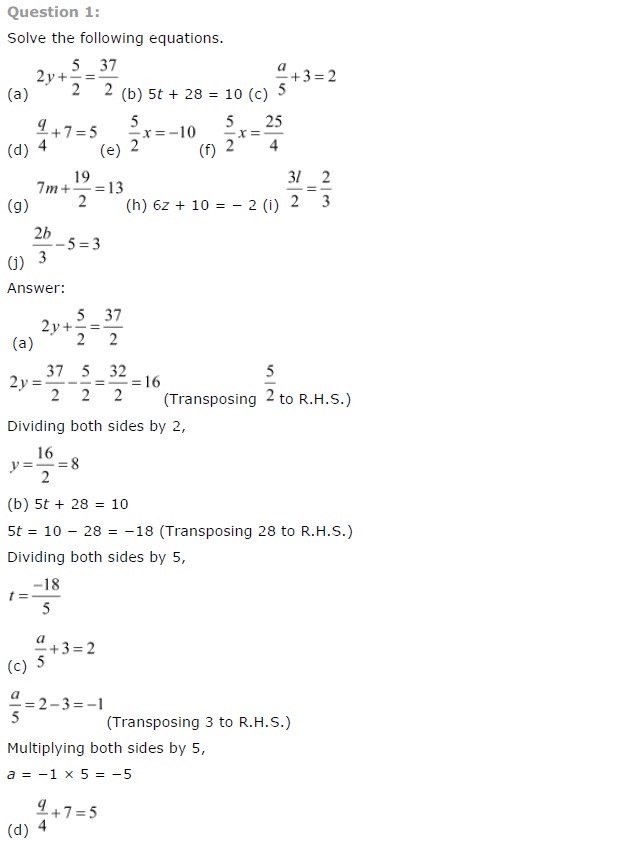
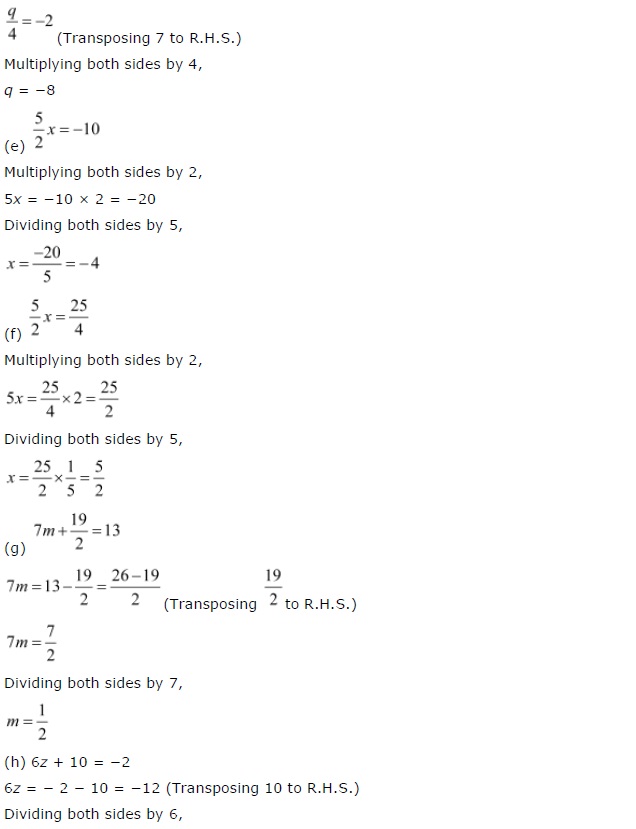
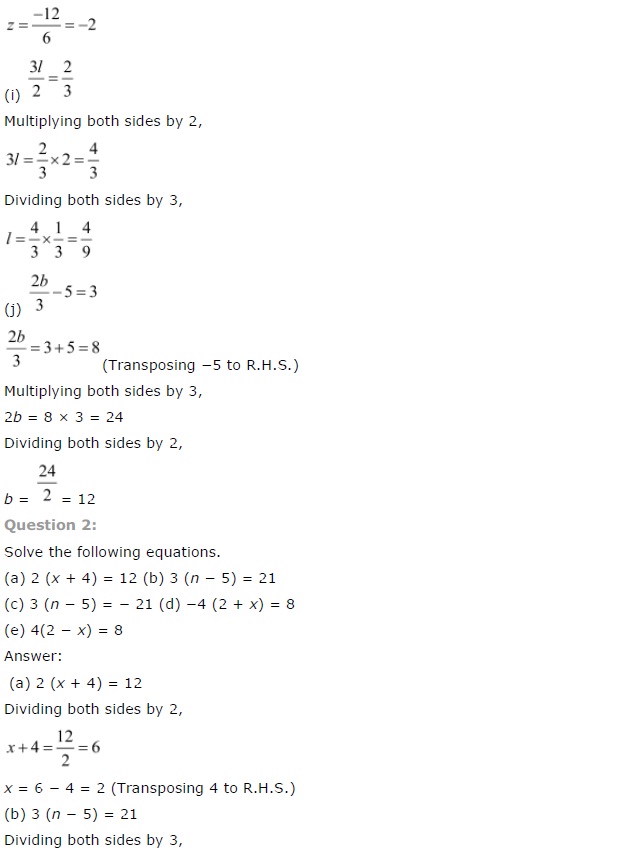
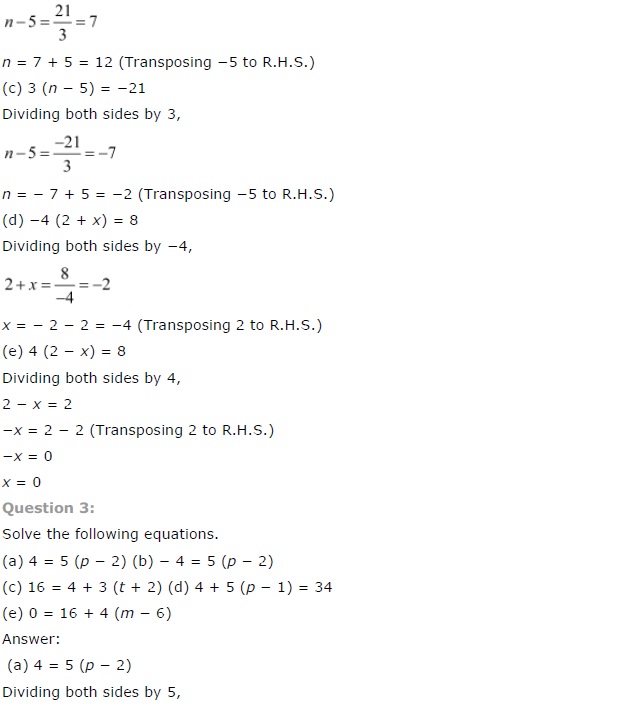
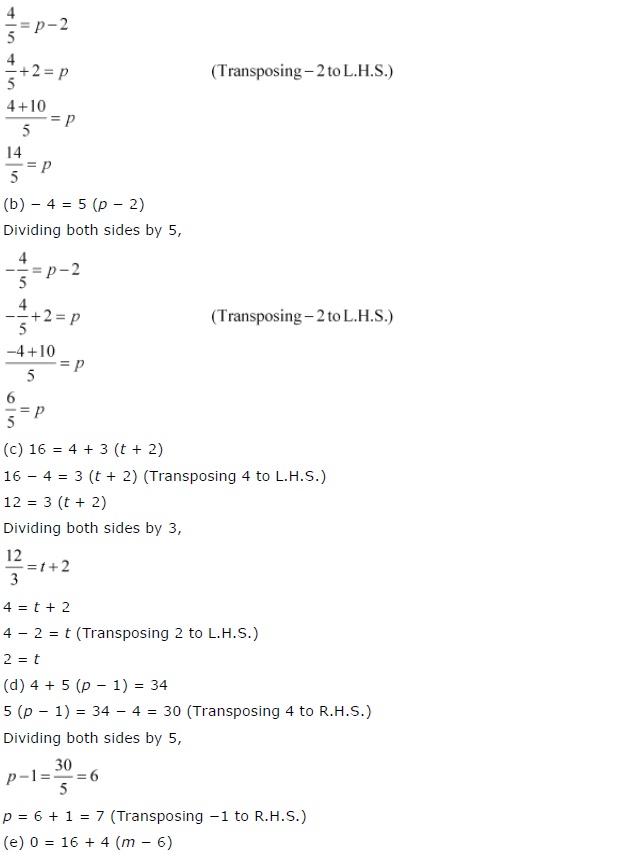
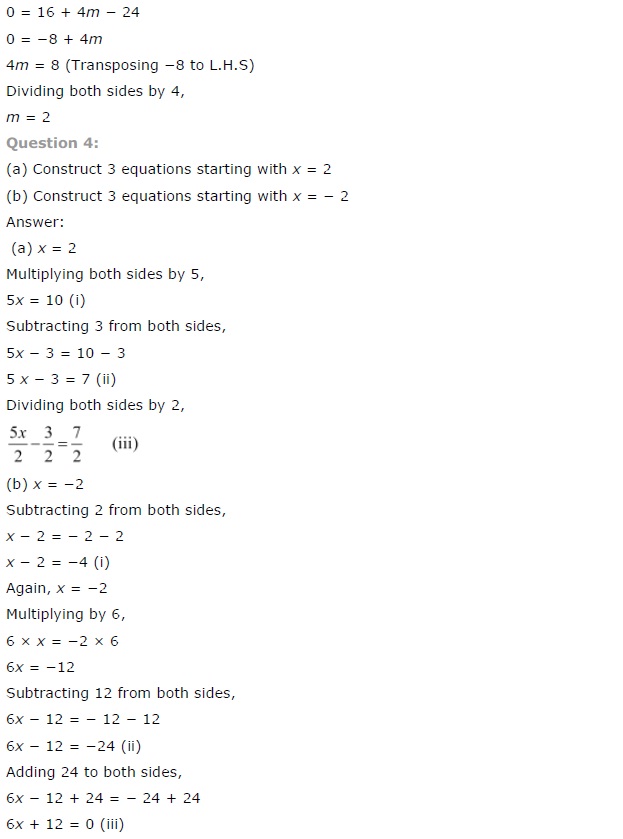
NCERT Solutions for Class 7 Maths Chapter 4 Simple Equations Exercise 4.4
Ex 4.4 Class 7 Maths Question 1.
Set up equations and solve them to find the unknown numbers in the following cases:
(a) Add 4 to eight times a number; you get 60.
(b) One-fifth of a number minus 4 gives 3.
(c) If I take three-fourths of a number and add 3 to it, I get 21.
(d) When I subtracted 11 from twice a number, the result was 15.
(e) Munna subtracts thrice the number of notebooks he has from 50, he finds the result to be 8.
(f) Ibenhal thinks of a number. If she adds 19 to it and divides the sum by 5, she will get 8.
(g) Anwar thinks of a number. If he takes away 7 from
Solution:
(a) Let the required number be x.
Step I: 8x + 4
Step II: 8x + 4 = 60 is the required equation
Solving the equation, we have
8x + 4 = 60
⇒ 8x = 60 – 4 (Transposing 4 to RHS)
⇒ 8x = 56
⇒
⇒ x = 7
Thus, x – 7 is the required unknown number.
(b) Let the required number be x.
Step I:
Step II:
Solving the equation, we get
⇒
⇒
⇒
⇒ x = 35 is the required unknown number,
(c) Let the required number be x.
Step I:
Step II:
Solving the equation, we have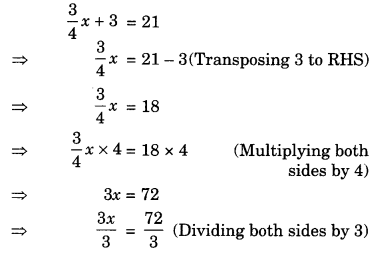
⇒ x = 24 is the required unknown number.
(d) Let the required unknown number be x.
Step I: 2x – 11
Step II: 2x -11 = 15 is the required equations.
Solving the equation, we have
2x – 11= 15
⇒ 2x = 15 + 13 (Transposing 11 to RHS)
⇒ 2x = 28
⇒
⇒ x = 14 is the required unknown number,
(e) Let the required number be x.
Step I: 50 – 3x
Step II: 50 – 3x = 8 is the required equations.
Solving the equation, we have
50 – 3x = 8
⇒ -3x = 8 – 50 (Transposing 50 to RHS)
⇒ -3x = -42
⇒
⇒ x = 14 is the required unknown number.
(f) Let the required number be x.
Step I: x + 19
Step II:
Step III:
Solving the equation, we have
⇒
⇒ x + 19 = 40
⇒ x = 40 – 19 (Transposing 19 to RHS)
∴ x = 21 is the required unknown number.
(g) Let the required number be x.
Step I:
Step II:
Solving the equation, we have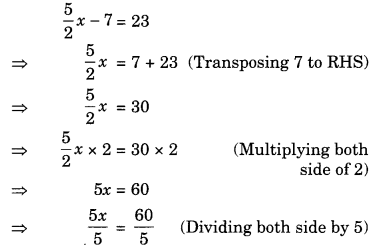
⇒ x = 12 is the required unknown number.
Ex 4.4 Class 7 Maths Question 2.
Solve the following:
(a) The teacher tells the class that the highest marks obtained by a student in her class is twice the lowest marks plus 7. The highest score is 87. What is the lowest score?
(b) In an isosceles triangle, the base angle are equal. The vertex angle is 40°. What are the base angles of the triangle? (Remember, the sum of three angles of a triangle is 180°?)
(c) Sachin scored twice as many runs as Rahul. Together, their runs fell two short of a double century. How many runs did each one score?
Solution:
(a) Let the lowest score be x.
Step I: Highest marks obtained = 2x + 7
Step II: 2x + 7 = 87 is the required equation. Solving the equation, we have
2x + 7 = 87
⇒ 2x = 87 – 7 (Transposing 7 to RHS)
⇒ 2x = 80
⇒
⇒ x = 40 is the required lowest marks.
(b) Let each base angle be x degrees.
Step I: Sum of all angles of the triangle (x + x + 40) degrees.
Step II: x + x + 40 = 180°
⇒ 2x + 40° = 180°
Solving the equation, we have
2x + 40° = 180°
2x = 180° – 40° (Transposing 40° to RHS)
2x = 140°
⇒
⇒ x = 70°
Thus the required each base angle = 70°
(c) Let the runs scored by Rahul = x
Runs scored by Sachin = 2x
Step I: x + 2x = 3x
Step II: 3x + 2 = 200
Solving the equation, we have
3x + 2 = 200
⇒ 3x = 200 – 2 (Transposing 2 to RHS)
⇒ 3x = 198
⇒
⇒ x = 66
Thus, the runs scored by Rahul is 66 and the runs scored by Sachin = 2 × 66 = 132
Ex 4.4 Class 7 Maths Question 3.
Solve the following:
(i) Irfan says that he has 7 marbles more than five times the marbles Parmit has. Irfan has 37 marbles. How many marbles does Parmit have?
(ii) Laxmi’s father is 49 years old. He is 4 years older than three times Laxmi’s age. What is Laxmi’s age?
(iii) People of Sundargram planted trees in a village garden. Some of the trees were fruit trees. The number of non-fruit trees were two more than three times the number of fruit trees. What was the number of fruit trees planted if the number of non-fruit trees planted was 77?
Solution:
(i) Let the number of marbles with Parmit be
Step I: Number of marbles that Irfan has = 5x + 7
Step II: 5x + 7 = 37 Solving the equation, we have 5x + 7 = 37
⇒ 5x = 37 – 7 (Transposing 7 to RHS)
⇒ 5x = 30
⇒
⇒ x = 6
Thus, the required number of marbles = 6.
(ii) Let Laxmi’s age be x years.
Step I: Father’s age = 3x + 4
Step II: 3x + 4 = 49
Solving the equation, we get
3x + 4-= 49
⇒ 3x = 49 – 4 (Transposing to RHS)
⇒ 3x = 45
⇒
⇒ x = 15
Thus, the age of Laxmi = 15 years
(iii) Let the number of planted fruit tree be x.
Step I: Number of non-fruit trees = 3x + 2
Step II: 3x + 2 = 77
Solving the equation, we have
3x + 2 = 77
⇒ 3x = 77 – 2 (Transposing 2 to RHS)
⇒ 3x = 75
⇒
⇒ x = 25
Thus, the required number of fruit tree planted = 25
Ex 4.4 Class 7 Maths Question 4.
Solve the following riddle:
I am a number,
Tell my identity!
Take me seven times over
And add a fifty!
To reach a triple century
You still need forty!
Solution:
Suppose my identity number is x.
Step I: 7 + 50
Step II: 7x + 50 + 40 = 300
or 7x + 90 = 300
Solving the equation, we have
7x + 90 = 300
⇒ 7x = 300 – 90 (Transforming 90 to RHS)
⇒ 7x = 210
⇒
⇒ x = 30
Thus, my identity is 30.
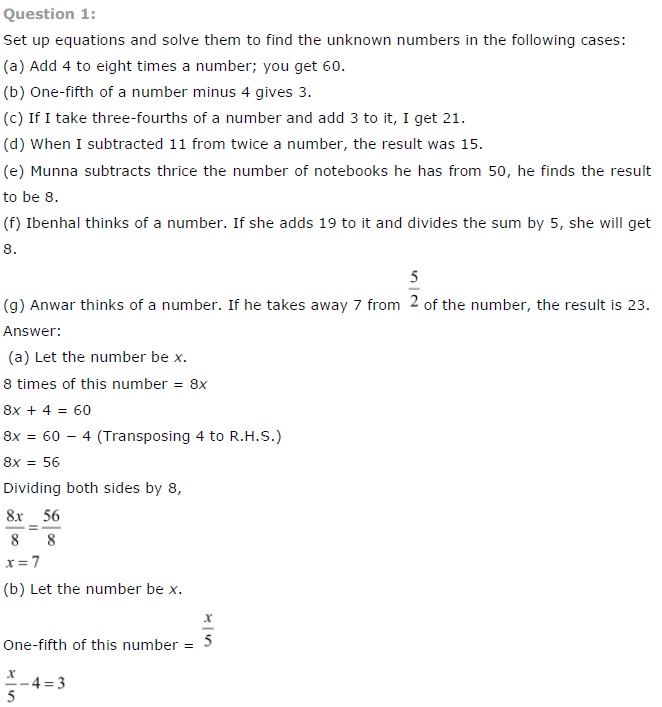
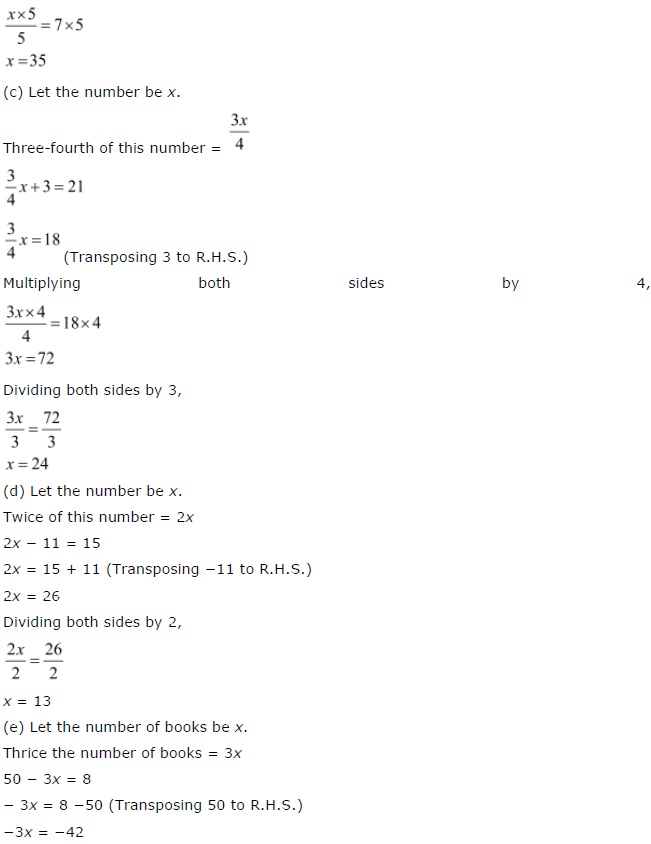
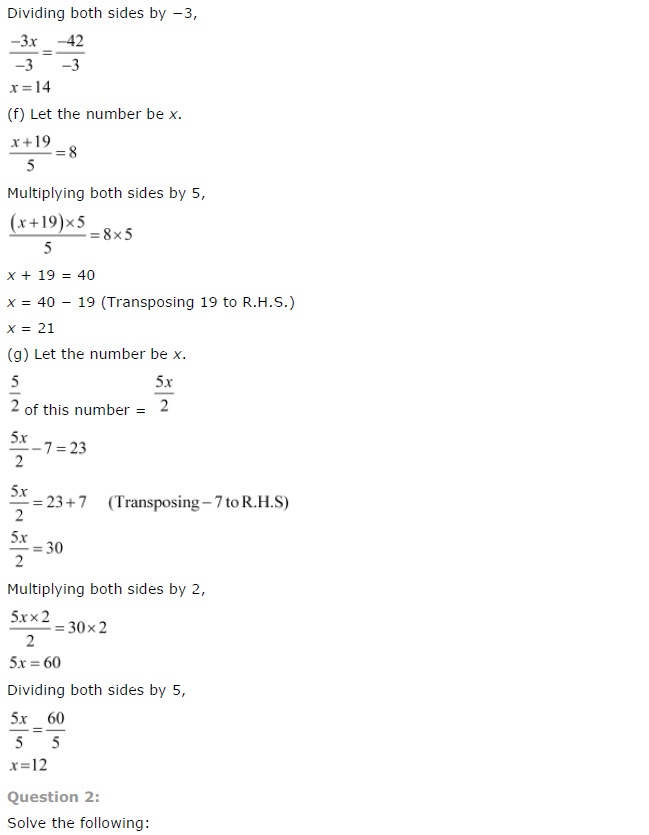
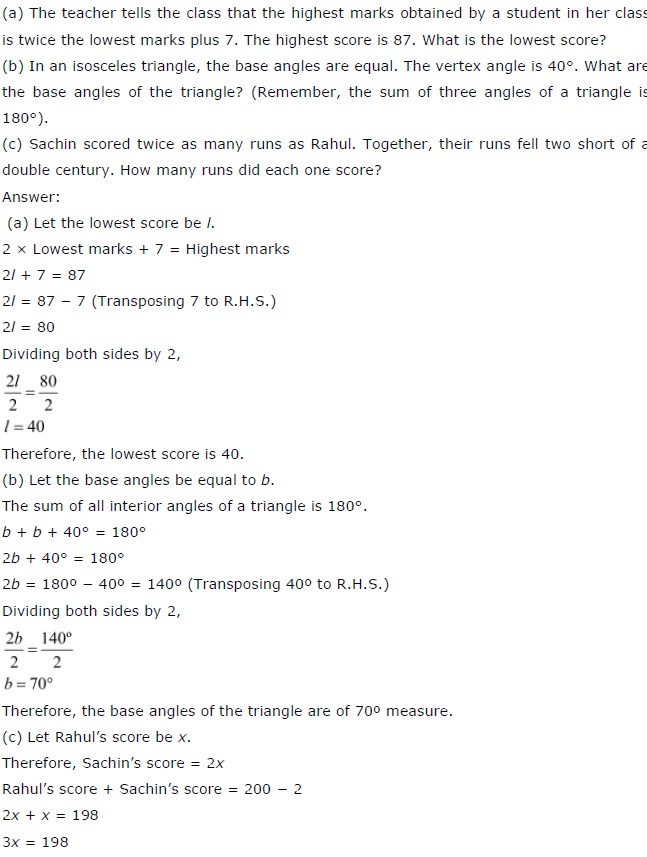
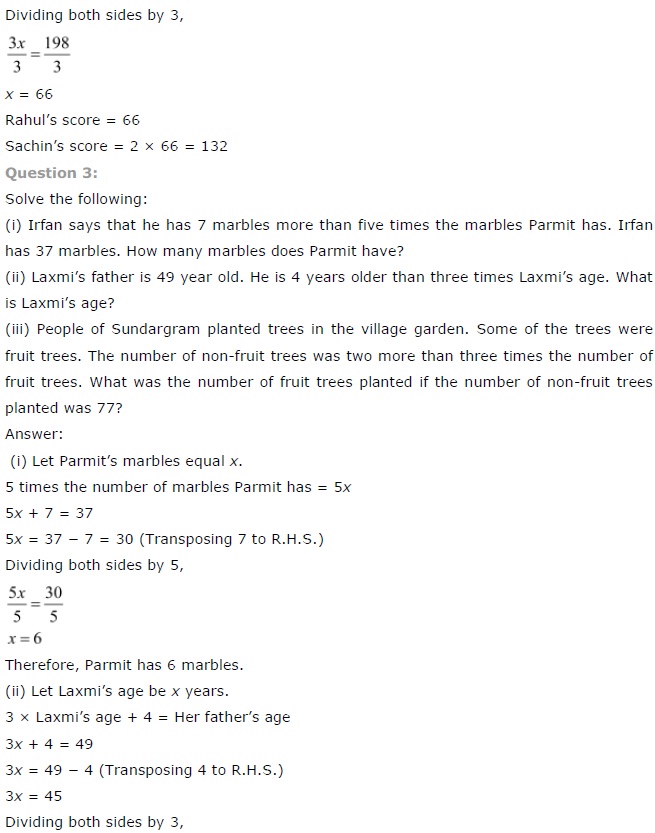
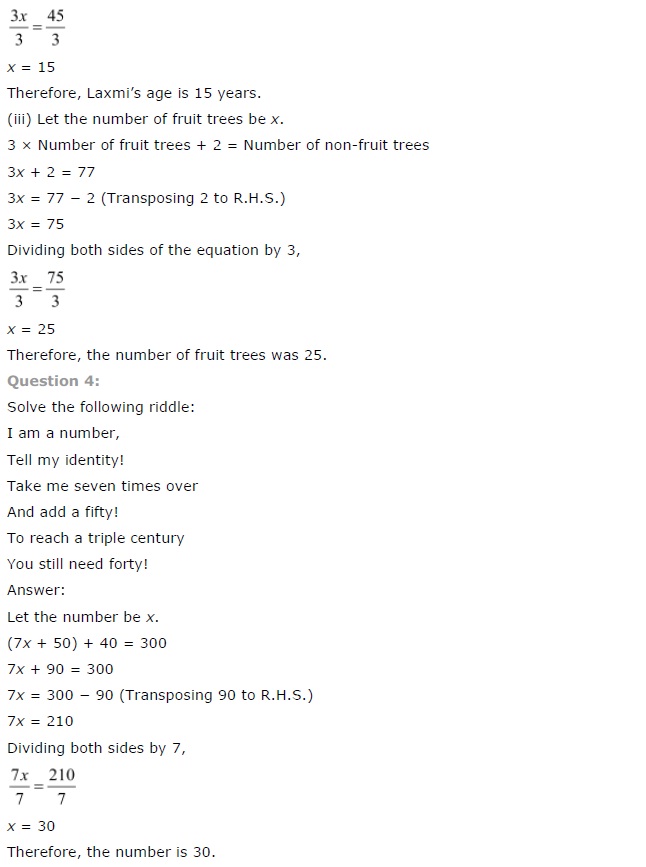
Simple Equations Class 7 Extra Questions Very Short Answer Type
Question 1.
Write the following statements in the form of equations.
(a) The sum of four times a number and 5 gives a number five times of it.
(b) One-fourth of a number is 2 more than 5.
Solution:
(a) Let the number be x.
Sum of 4x and 5 = 4x + 5
The sum is 5x.
The equation is 4x + 5 = 5x as required.
(b) Let the number be x.
⇒
Question 2.
Convert the following equations in statement form:
(a) 5x = 20
(b) 3y + 7 = 1
Solution:
(a) Five times a number x gives 20.
(b) Add 7 to three times a number y gives 1.
Question 3.
If k + 7 = 10, find the value of 9k – 50.
Solution:
k + 7 = 10
⇒ k = 10 – 7 = 3
Put k = 3 in 9k – 50, we get
9 × 3 – 50 = 27 – 50 = -23
Thus the value of k = -23
Question 4.
Solve the following equations and check the answers.![]()
Solution:

Question 5.
Solve the following equations:
3(y – 2) = 2(y – 1) – 3
Solution:
3(y – 2) = 2(y – 1) – 3
⇒ 3y – 6 = 2y – 2 – 3 (Removing the brackets)
⇒ 3y – 6 = 2y – 5
⇒ 3y – 2y = 6 – 5 (Transposing 6 to RHS and 2y to LHS)
⇒ y = 1
Thus y = 1
Question 6.
If 5 is added to twice a number, the result is 29. Find the number.
Solution:
Let the required number be x.
Step I: 2x + 5
Step II: 2x + 5 = 29
Solving the equation, we get
2x + 5 = 29
⇒ 2x = 29 – 5 (Transposing 5 to RHS)
⇒ 2x = 24
⇒ x = 12 (Dividing both sides by 2)
⇒ x = 12
Thus the required number is 12.
Question 7.
If one-third of a number exceeds its one-fourth by 1, find the number.
Solution:
Let the required number be x.
Simple Equations Class 7 Extra Questions Short Answer Type
Question 8.
The length of a rectangle is twice its breadth. If its perimeter is 60 cm, find the length and the breadth of the rectangle.
Solution:
Let the breadth of the rectangle be x cm.
its length = 2x
Perimeter = 2 (length + breadth) = 2(2x + x) = 2 × 3x = 6x
As per the condition of the question, we have
6x = 60 ⇒ x = 10
Thus the required breadth = 10 cm
and the length = 10 × 2 = 20 cm.
Question 9.
Seven times a number is 12 less than thirteen times the same number. Find the number.
Solution:
Let the required number be x.
7x = 13x – 12
⇒ 7x – 13x = -12 (Transposing 13x to LHS)
⇒ -6x = -12
⇒ x = 2
Thus, the required number is 2.
Question 10.
The present age of a son is half the present age of his father. Ten years ago, the father was thrice as old as his son. What are their present age?
Solution:
Let the present age of a father be x years.
Son’s age =
10 years ago, father’s age was (x – 10) years
10 years ago, son’s age was (
As per the question, we have
Question 11.
The sum of three consecutive multiples of 2 is 18. Find the numbers.
Solution:
Let the three consecutive multiples of 2 be 2x, 2x + 2 and 2x + 4.
As per the conditions of the question, we have
2x + (2x + 2) + (2x + 4) = 18
⇒ 2x + 2x + 2 + 2x + 4 = 18
⇒ 6x + 6 = 18
⇒ 6x = 18 – 6 (Transposing 6 to RHS)
⇒ 6x = 12
⇒ x = 2
Thus, the required multiples are
2 × 2 = 4, 4 + 2 = 6, 6 + 2 = 8 i.e., 4, 6 and 8.
Question 12.
Each of the 2 equal sides of an isosceles triangle is twice as large as the third side. If the perimeter of the triangle is 30 cm, find the length of each side of the triangle. [NCERT Exemplar]
Solution:
Let the length of the third side be x cm.
Each equal side = 2x cm.
As per the condition of the question, we have
Perimeter = x + 2x + 2x = 30
⇒ 5x = 30
⇒ x = 6
Thus, the third side of the triangle = 6 cm
and other two equal sides are 2 × 6 = 12 cm each
Question 13.
A man travelled two-fifth of his journey by train, one-third by bus, one-fourth by car and the remaining 3 km on foot. What is the length of his total journey? [NCERT Exemplar]
Solution:
Let the total length of total journey be x km.
Distance travelled by train =
Distance travelled by bus =
Distance travelled by car =
Remaining distance = 3 km
As per the question, we have
Thus, the required journey = 180 km.
.png)
.png)